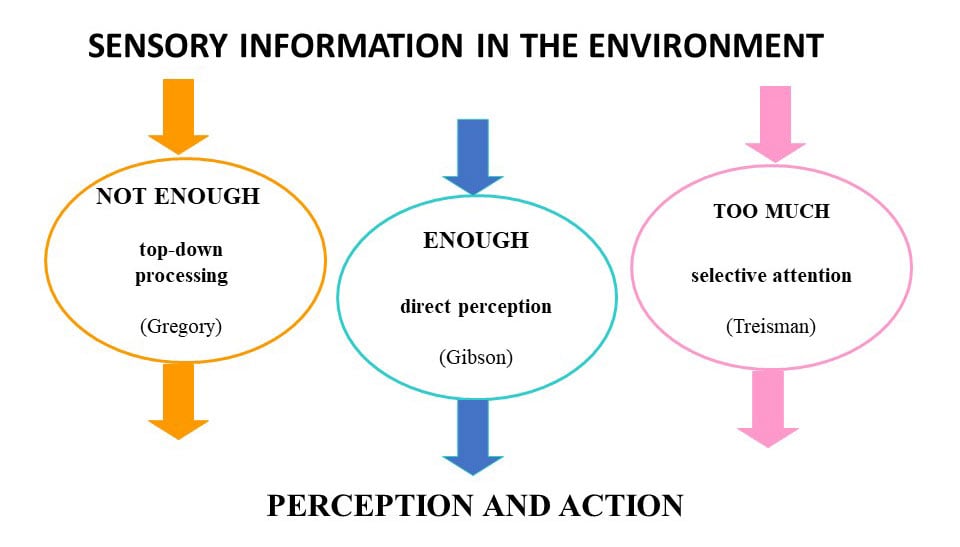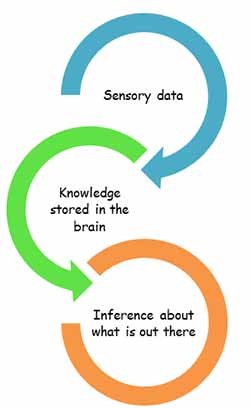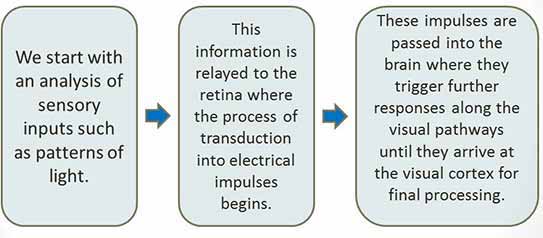On This Page:

What is Visual Perception?
To receive information from the environment, we are equipped with sense organs, e.g., the eye, ear, and nose. Each sense organ is part of a sensory system that receives sensory inputs and transmits sensory information to the brain.
A particular problem for psychologists is explaining how the physical energy received by sense organs forms the basis of perceptual experience. Sensory inputs are somehow converted into perceptions of desks and computers, flowers and buildings, cars and planes, into sights, sounds, smells, tastes, and touch experiences.
A major theoretical issue on which psychologists are divided is the extent to which perception relies directly on the information present in the environment. Some argue that perceptual processes are not direct but depend on the perceiver’s expectations and previous knowledge as well as the information available in the stimulus itself.

This controversy is discussed with respect to Gibson (1966), who has proposed a direct theory of perception which is a “bottom-up” theory, and Gregory (1970), who has proposed a constructivist (indirect) theory of perception which is a “top-down” theory.
Psychologists distinguish between two types of processes in perception: bottom-up processing and top-down processing.
Bottom-up processing is also known as data-driven processing because perception begins with the stimulus itself. Processing is carried out in one direction from the retina to the visual cortex, with each successive stage in the visual pathway carrying out an ever more complex analysis of the input.
Top-down processing refers to the use of contextual information in pattern recognition. For example, understanding difficult handwriting is easier when reading complete sentences than reading single and isolated words. This is because the meaning of the surrounding words provides a context to aid understanding.
Gregory (1970) and Top-Down Processing Theory

Psychologist Richard Gregory (1970) argued that perception is a constructive process that relies on top-down processing.
Stimulus information from our environment is frequently ambiguous, so to interpret it, we require higher cognitive information either from past experiences or stored knowledge in order to make inferences about what we perceive. Helmholtz called it the ‘likelihood principle’.
For Gregory, perception is a hypothesis which is based on prior knowledge. In this way, we are actively constructing our perception of reality based on our environment and stored information.
Summary
- A lot of information reaches the eye, but much is lost by the time it reaches the brain (Gregory estimates about 90% is lost).
- Therefore, the brain has to guess what a person sees based on past experiences. We actively construct our perception of reality.
- Richard Gregory proposed that perception involves a lot of hypothesis testing to make sense of the information presented to the sense organs.
- Our perceptions of the world are hypotheses based on past experiences and stored information.
- Sensory receptors receive information from the environment, which is then combined with previously stored information about the world which we have built up as a result of experience.
- The formation of incorrect hypotheses will lead to errors of perception (e.g., visual illusions like the Necker cube).
Supporting Evidence
There seems to be an overwhelming need to reconstruct the face, similar to Helmholtz’s description of “unconscious inference.” An assumption based on past experience.
Perceptions can be ambiguous

The Necker cube is a good example of this. When you stare at the crosses on the cube, the orientation can suddenly change or “flip.”
It becomes unstable, and a single physical pattern can produce two perceptions.
Gregory argued that this object appears to flip between orientations because the brain develops two equally plausible hypotheses and is unable to decide between them.
When the perception changes though there is no change in the sensory input, the change of appearance cannot be due to bottom-up processing. It must be set downwards by the prevailing perceptual hypothesis of what is near and what is far.
Perception allows behavior to be generally appropriate to non-sensed object characteristics.
Critical Evaluation of Gregory’s Theory
1. The Nature of Perceptual Hypotheses
If perceptions make use of hypothesis testing, the question can be asked, “what kind of hypotheses are they?” Scientists modify a hypothesis according to the support they find for it, so are we, as perceivers, also able to modify our hypotheses? In some cases, it would seem the answer is yes. For example, look at the figure below:

This probably looks like a random arrangement of black shapes. In fact, there is a hidden face in there; can you see it? The face is looking straight ahead and is in the top half of the picture in the center. Now can you see it? The figure is strongly lit from the side and has long hair and a beard.
Once the face is discovered, very rapid perceptual learning takes place and the ambiguous picture now obviously contains a face each time we look at it. We have learned to perceive the stimulus in a different way.
Although in some cases, as in the ambiguous face picture, there is a direct relationship between modifying hypotheses and perception, in other cases, this is not so evident. For example, illusions persist even when we have full knowledge of them (e.g., the inverted face, Gregory 1974).
One would expect that the knowledge we have learned (from, say, touching the face and confirming that it is not “normal”) would modify our hypotheses in an adaptive manner. The current hypothesis testing theories cannot explain this lack of a relationship between learning and perception.
2. Perceptual Development
A perplexing question for the constructivists who propose perception is essentially top-down in nature is “how can the neonate ever perceive?” If we all have to construct our own worlds based on past experiences, why are our perceptions so similar, even across cultures? Relying on individual constructs for making sense of the world makes perception a very individual and chancy process.
The constructivist approach stresses the role of knowledge in perception and therefore is against the nativist approach to perceptual development.
However, a substantial body of evidence has been accrued favoring the nativist approach. For example, Newborn infants show shape constancy (Slater & Morison, 1985); they prefer their mother’s voice to other voices (De Casper & Fifer, 1980); and it has been established that they prefer normal features to scrambled features as early as 5 minutes after birth.
3. Sensory Evidence
Perhaps the major criticism of the constructivists is that they have underestimated the richness of sensory evidence available to perceivers in the real world (as opposed to the laboratory, where much of the constructivists” evidence has come from).
Constructivists like Gregory frequently use the example of size constancy to support their explanations. That is, we correctly perceive the size of an object even though the retinal image of an object shrinks as the object recedes. They propose that sensory evidence from other sources must be available for us to be able to do this.
However, in the real world, retinal images are rarely seen in isolation (as is possible in the laboratory). There is a rich array of sensory information, including other objects, background, the distant horizon, and movement. This rich source of sensory information is important to the second approach to explaining perception that we will examine, namely the direct approach to perception as proposed by Gibson.
Gibson argues strongly against the idea that perception involves top-down processing and criticizes Gregory’s discussion of visual illusions on the grounds that they are artificial examples and not images found in our normal visual environments.
This is crucial because Gregory accepts that misperceptions are the exception rather than the norm. Illusions may be interesting phenomena, but they might not be that information about the debate.
Gibson (1966) and Bottom-Up Processing
Gibson’s bottom-up theory suggests that perception involves innate mechanisms forged by evolution and that no learning is required. This suggests that perception is necessary for survival – without perception, we would live in a very dangerous environment.
Our ancestors would have needed perception to escape from harmful predators, suggesting perception is evolutionary.
James Gibson (1966) argues that perception is direct and not subject to hypothesis testing, as Gregory proposed. There is enough information in our environment to make sense of the world in a direct way.
His theory is sometimes known as the ‘Ecological Theory’ because of the claim that perception can be explained solely in terms of the environment.
For Gibson: the sensation is perception: what you see is what you get. There is no need for processing (interpretation) as the information we receive about size, shape, distance, etc., is sufficiently detailed for us to interact directly with the environment.
Gibson (1972) argued that perception is a bottom-up process, which means that sensory information is analyzed in one direction: from simple analysis of raw sensory data to the ever-increasing complexity of analysis through the visual system.

Features of Gibson’s Theory
The optic array
Perception involves ‘picking up’ the rich information provided by the optic array in a direct way with little/no processing involved.
Because of movement and different intensities of light shining in different directions, it is an ever-changing source of sensory information. Therefore, if you move, the structure of the optic array changes.
According to Gibson, we have the mechanisms to interpret this unstable sensory input, meaning we experience a stable and meaningful view of the world.
Changes in the flow of the optic array contain important information about what type of movement is taking place. The flow of the optic array will either move from or towards a particular point.
If the flow appears to be coming from the point, it means you are moving towards it. If the optic array is moving towards the point, you are moving away from it.
Invariant Features
the optic array contains invariant information that remains constant as the observer moves. Invariants are aspects of the environment that don’t change. They supply us with crucial information.
Two good examples of invariants are texture and linear perspective.

Another invariant is the horizon-ratio relation. The ratio above and below the horizon is constant for objects of the same size standing on the same ground.
OPTICAL ARRAY: The patterns of light that reach the eye from the environment.
RELATIVE BRIGHTNESS: Objects with brighter, clearer images are perceived as closer
TEXTURE GRADIENT: The grain of texture gets smaller as the object recedes. Gives the impression of surfaces receding into the distance.
RELATIVE SIZE: When an object moves further away from the eye, the image gets smaller. Objects with smaller images are seen as more distant.
SUPERIMPOSITION: If the image of one object blocks the image of another, the first object is seen as closer.
HEIGHT IN THE VISUAL FIELD: Objects further away are generally higher in the visual field
Evaluation of Gibson’s (1966) Direct Theory of Perception
Gibson’s theory is a highly ecologically valid theory as it puts perception back into the real world.
A large number of applications can be applied in terms of his theory, e.g., training pilots, runway markings, and road markings.
It’s an excellent explanation for perception when viewing conditions are clear. Gibson’s theory also highlights the richness of information in an optic array and provides an account of perception in animals, babies, and humans.
His theory is reductionist as it seeks to explain perception solely in terms of the environment. There is strong evidence to show that the brain and long-term memory can influence perception. In this case, it could be said that Gregory’s theory is far more plausible.
Gibson’s theory also only supports one side of the nature-nurture debate, that being the nature side. Again, Gregory’s theory is far more plausible as it suggests that what we see with our eyes is not enough, and we use knowledge already stored in our brains, supporting both sides of the debate.
Visual Illusions
Gibson’s emphasis on DIRECT perception provides an explanation for the (generally) fast and accurate perception of the environment. However, his theory cannot explain why perceptions are sometimes inaccurate, e.g., in illusions.
He claimed the illusions used in experimental work constituted extremely artificial perceptual situations unlikely to be encountered in the real world, however, this dismissal cannot realistically be applied to all illusions.
For example, Gibson’s theory cannot account for perceptual errors like the general tendency for people to overestimate vertical extents relative to horizontal ones.
Neither can Gibson’s theory explain naturally occurring illusions. For example, if you stare for some time at a waterfall and then transfer your gaze to a stationary object, the object appears to move in the opposite direction.
Bottom-up or Top-down Processing?
Neither direct nor constructivist theories of perception seem capable of explaining all perceptions all of the time.
Gibson’s theory appears to be based on perceivers operating under ideal viewing conditions, where stimulus information is plentiful and is available for a suitable length of time. Constructivist theories, like Gregory”s, have typically involved viewing under less-than-ideal conditions.
Research by Tulving et al. manipulated both the clarity of the stimulus input and the impact of the perceptual context in a word identification task. As the clarity of the stimulus (through exposure duration) and the amount of context increased, so did the likelihood of correct identification.
However, as the exposure duration increased, so the impact of context was reduced, suggesting that if stimulus information is high, then the need to use other sources of information is reduced.
One theory that explains how top-down and bottom-up processes may be seen as interacting with each other to produce the best interpretation of the stimulus was proposed by Neisser (1976) – known as the “Perceptual Cycle.”
References
DeCasper, A. J., & Fifer, W. P. (1980). Of human bonding: Newborns prefer their mothers” voices. Science, 208(4448), 1174-1176.
Gibson, J. J. (1966). The Senses Considered as Perceptual Systems. Boston: Houghton Mifflin.
Gibson, J. J. (1972). A Theory of Direct Visual Perception. In J. Royce, W. Rozenboom (Eds.). The Psychology of Knowing. New York: Gordon & Breach.
Gregory, R. (1970). The Intelligent Eye. London: Weidenfeld and Nicolson.
Gregory, R. (1974). Concepts and Mechanisms of Perception. London: Duckworth.
Necker, L. (1832). LXI. Observations on some remarkable optical phenomena seen in Switzerland; and on an optical phenomenon which occurs on viewing a figure of a crystal or geometrical solid. The London and Edinburgh Philosophical Magazine and Journal of Science, 1 (5), 329-337.
Slater, A., Morison, V., Somers, M., Mattock, A., Brown, E., & Taylor, D. (1990). Newborn and older infants” perception of partly occluded objects. Infant behavior and Development, 13(1), 33-49.

